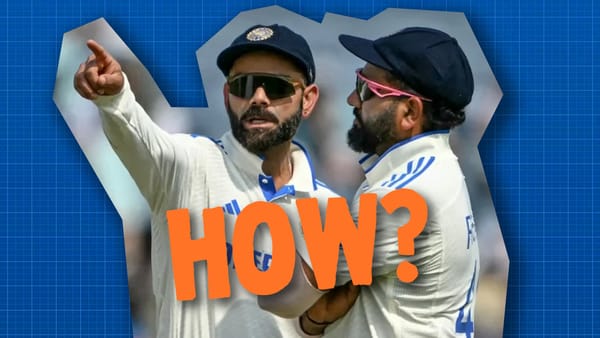The good bad ball
In T20 cricket the definition of a good ball is different, and so we take a look at the off spinning ball down legside.
"Good ball, Sok".
Josh Philippe, 2020.
The delivery that Philippe was referring to was not what one that comes to mind as something worth praising. O'Keefe was bowling his left-arm orthodox around the wicket to a left-hander, he dropped the ball a bit short, pitched it outside leg stump, and turned it further away. It's most likely run-scoring option was a wide, leg byes or an inside edge past short fine leg. It could only take a wicket from dragging it to backward square or have it hit his body, roll through his legs, and trickle onto the stumps.
If your left arm finger spinner was playing a club game, there would have been gentle advice to shift his line, or length, or both, and really it would have been humped around the corner for runs.
If you look at offspinners (there are more right vs right battles than left vs left) that pitch the ball outside leg stump, they go at 10 runs an over in the last two years of T20 and they average 59. But this was a good ball - not traditionally or aesthetically - because it only went for a single, was bowled to his field, and the plan was to give the left-handed Colin Ingram no room. And it worked.
Finger spin is cricket’s rubbish skill. Every batsman thinks they can do it.
— Jarrod Kimber (@ajarrodkimber) 10:34 AM ∙ Dec 5, 2020
So it was fundamentally a good ball in T20 and without question a bad cricket delivery pretty much everywhere else. That is how T20 cricket differs from other forms of the game.
And this isn't new information, since slower ball bouncers limited overs cricket has been heading this direction. When you're bowling what we used to call a long hop as a tactical change up to a long boundary, the game was fundamentally different. These new balls are not even pretending to be about wickets. That is a spoiler ball, its sole intent is to limit runs, and, O'Keefe bowls a lot of them to left-handers.
If you've been following T20 cricket - even hate-watching - you'll know that many off spinners bowl around the wicket to right-handers now. A mirror image of what O'Keefe did. It's not new, since 2011 25% of off spin to righties has been from around the wicket. Perhaps because in 2011 it started so well, offies were averaging 19.9 coming around the wicket, and 27.5 over the wicket.

But since then with bowlers getting even more defensive with it, the averages are going towards the shape you would expect. The weird thing is that it hasn't shown as more defensive in economy rates.

In one year it was less runs per over. It was close in two others as well, but bowling around to right-handers for an offie means you are less likely to get a wicket and more likely to get hit. The average over the wicket is 27.2 compared to 29.9, that's a decent difference. And econ over the wicket is 7.4 compared with 8.1 around. That's even more significant.
My first thought was that perhaps leg byes were an issue, but I really struggled to find proper data for that. I found a bit more on wides, and yeah, they might matter.
Despite only bowling 25% of the balls from around the wicket, offies there make up 32% of the wides. Meaning they are bowling a wide every 13.7 balls compared to every 16 balls from over the wicket. This makes sense if you're bowling from around the wicket, pitching outside leg and spinning further away. And teams are now willing to have a few wides bowled, they believe that the one run is worth the risk in a defensive tactic.
It's not one run, though. A wide is worth one run, a bowler delivering around the wicket off spin is going at 1.59 runs per balls, so every wide is worth 2.59 runs to the opposition in this period. That is part of the reason this tactic doesn't work as many bowlers think. But it's not all of it.
I think this is a tactic done more to players who are seen as dangerous to off spinners. If you're willing to drop your chances of a wicket, it's because you think this is the best chance of getting out of your over. You wouldn't do that to a batsman who isn't seen as an excellent player of spin. So it is a backup option for many. That is how I have sold it to offies I have worked with. Start by pitching every ball so it will hit the stumps, but if they are hitting you, bowling a leg stump line from around the wicket to squeeze out a dot or two.
But there are specialists, Glenn Maxwell bowls 87% of his deliveries from around the wicket. His econ is .1 run better from around the wicket, and he averages 30 around, and 54 over (from a fairly limited sample size, so that could regress).
I went and looked at the ten off spinners who bowl the most to right-handed batsmen. It's a good mix, IPL guy, mystery bowlers, Big Bash bloke, and a few blast chaps.

Chris Green who bowls around the wicket the most, and it wasn't close. That makes sense, as he's by far the most defensive bowler in this list (like Maxwell). And Narine bowls from there less than 1% of the time as he's the most attacking. As you can see, only three of these guys are above 25%, meaning that good offies are probably not doing it as much. Which also makes sense.
That leads me to think that it is the part-timers and fringe players (perhaps who are brought in to target some lefties) who are bowling it more often. Because they've already been hit over the wicket.
But there is more interesting stuff in this top ten.

Take Green, he averages better around the wicket but is much more economical over. If you know Simon Harmer, probably best to let him know that he bowls around the wicket far too much, where he is a run an over and ten runs a wicket worse. Moeen should give it a rest too. Jeetan Patel could possibly have done it more, or he picked his moments absolutely perfectly. Colin Ackermann has bowled 18 balls around the wicket to righties, they've smoked him for 48 runs. That could be a fluke, but you can see why he'd rather not bowl from there.
What this shows is that unlike a yorker, or an outswinger just missing the off bail, this isn't a good ball for everyone. In T20 a good ball might be a bad ball, but that good ball might be a bad ball for someone else.
And that is another thing I learned from working with teams. Often players don't practice these other skills enough. Say you're in a game where cramping the opposition batsman is your best option. But you haven't worked on coming around and landing it on a spot near leg stump. You might bowl too much on the stumps, and give them a free swing to leg. Or you'll start it too wide, giving them extra runs or a near free hit. Bowling a consistent corridor outside leg is the same as the normal corridor, it takes practice to get it right.
Essentially, your good bad ball might end up being a bad bad ball.
The latest Red Inker is with Ram Guha.
My latest on Youtube is about how Ravi Jadeja can bat now.




